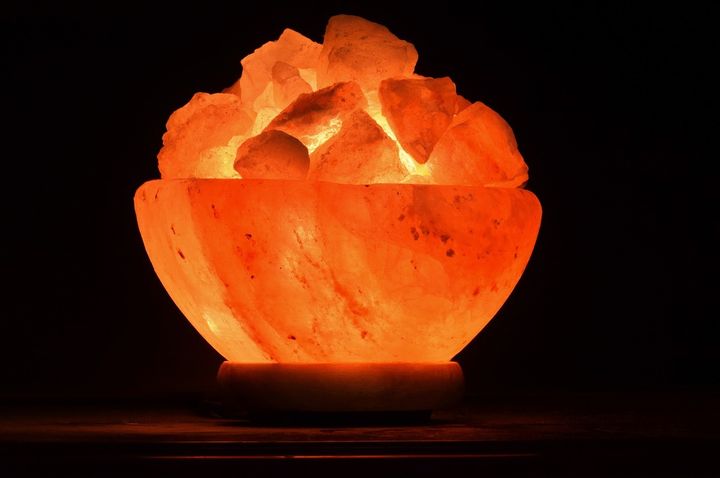
Himalayan salt lamp.
In January of this year, national retailer Michael’s issued a recall of 80,000 Himalayan salt lamps packaged under the Lumiere brand name, according to USA Today. The offending culprit, the U.S. Product and Safety Commission stated, was a defective dimmer switch/outlet plug which could overheat, cause shock or catch fire.
That a major retailer like Michael’s was even carrying salt lamps is in itself a testament to the swelling popularity of these items. Since the 1980s, the health conscious have been touting the benefits of Himalayan salt, creating a cottage industry and movement that has ultimately made its way into the mainstream. But even though the recent recall was no statement against the effectiveness of salt lamps in general, it has apparently sparked fresh debate about salt lamps in general. Do they really work? Are they a legitimate health product or just a pretty room décor item? Or worse, are salt lamps a hoax?
Growing Scientific Evidence
The primary health benefit of salt lamps, according to advocates, is that they emit negative ions which are believed to remove pollutants from the air, improve mood and even alleviate respiratory issues. To understand this concept more fully, let’s look at a natural phenomenon that has the reverse effect of sending positive ions into the air.
Several times a year in southern California, the hot, dry Santa Ana Winds slope down from the eastern mountains toward the sea, often exceeding speeds of 40 mph. There seems to be a noted increase in irritability, hostility and other negative emotions in the residents of this region when these winds are blowing—even an increase in crime. The likely reason for this emotional shift, the New York Times reports, are that these winds are heavy with positive ions which can cause irritability. Conversely, the idea is that air containing negative ions has the opposite effect, evoking calm and making breathing easier. Salt-infused air is rich in these negative ions, which may account for the reason why people tend to be more relaxed by the ocean, and why even doctors have recommended trips to the coast for some of their respiratory patients.
While skepticism remains within the medical community, a growing body of studies is confirming the legitimacy of the concept known as salt therapy. As early as the 1840s, a Polish physician named Felix Boczkowski noticed that salt miners in the Wieleczka salt mines had remarkably low instances of respiratory issues and surmised that the salty air in the caves might be the reason. More recent studies are confirming the positive effects of salt therapy in treating a number of respiratory ailments, including asthma, bronchitis and other diseases. These studies appear to confirm what health enthusiasts have been saying for years: salt in the air is good for you, and therefore salt lamps will make the air in your home better.
How Salt Lamps Work
The concept of the salt lamp is a simple one: a block of salt (or a bowl of salt crystals) is gently warmed by a candle or electric bulb. This warming causes moisture in the air to condense onto the salt, causing the salt molecules to split and release negative ions into the air. Himalayan salt (recognized by its pink hue) is typically used because it is mined from high elevations free of pollutants in the air, and is therefore considered the purest salt available. Salt lamp expert Richard Ori of Spiritual Quest explains the benefits more specifically:
“Negative ions are oxygen molecules with a negative charge,” he says, “allowing the person to take in up to 20-30% more oxygen, leading to immune boost, relief from stress and a benefit to those with breathing ailments.”
The Rise of Fake or Faulty Products
With any growing industry based on a popular trend, some bad seeds get involved from time to time, turning out faulty or fake products. The salt lamp industry has been no exception; some manufacturers have been known to produce impure or fake salt products, and unwitting salt lamp vendors have sold them to the public, dismaying the purists while giving credence to some of the critics. As Richard Ori states, this issue can be resolved simply by vendors screening their suppliers more carefully. “It is important to find a direct-from-the-source supplier,” says Ori. “Himalayan salt comes in many quality grades.”
Telling the Difference between Authentic and Fake
How can you tell whether your salt lamp is authentic, or whether you’re dealing with a good supplier? Here are a few telltale signs:
- Authentic or pure salt will “sweat.” Remember, negative ions are released by condensation of water. If your salt lamp gets moist on the surface (especially in humid air), it’s doing its job correctly. If not, you may have a fake.
- Authentic salt lamps emit a muted glow. Natural Himalayan salt contains other trace minerals that give the crystal its pink-orange hue. This means your lamp should glow when lit, but it shouldn’t light up the whole room. If it does, you probably have a fake.
- Authentic salt is fragile. It seems counterintuitive to say “If your lamp breaks easily, it’s real.” However, it’s true, to the point that sometimes pure salt crystals will chip away slightly during shipping. Not suggesting you try to break your lamp, but if someone accidentally knocks it over and it doesn’t chip or break, you should be suspicious.
While the debate over the effectiveness of salt lamps is likely to continue, it seems very few people who buy them complain about them; in fact, they usually return to their vendors to buy more. For that reason, it’s unlikely that the recent recall or even the rise of impostors will dim the glow of the salt lamp industry in the coming years. If you’re a believer, the only caution is to double check with your suppliers to make sure you’re getting the real thing.
